-
 KIM, YONGGYUNposition Graduate (Master of Science)major Insect Molecular PhysiologyTel +82-54-820-6236E-mail hosanna@anu.ac.krAcademic Seoul National University (BS)
KIM, YONGGYUNposition Graduate (Master of Science)major Insect Molecular PhysiologyTel +82-54-820-6236E-mail hosanna@anu.ac.krAcademic Seoul National University (BS)
Seoul National University (MS)
Iowa State University (PhD)Society Editor-in-Chief Archives of Insect Biochemistry and Physiology
Member Korean Academy of Science and TechnologyTeaching Insect Molecular Physiology
Insecticide Toxicology
Advanced Biochemistry
Research
-
Based on experience on different insects and their physiological processes I have studied for last 27 years, I would like to further analyze eicosanoid influence on various physiological processes of insects in chemical identification, biosynthesis, receptor-based signal transduction, and physiological changes.
-
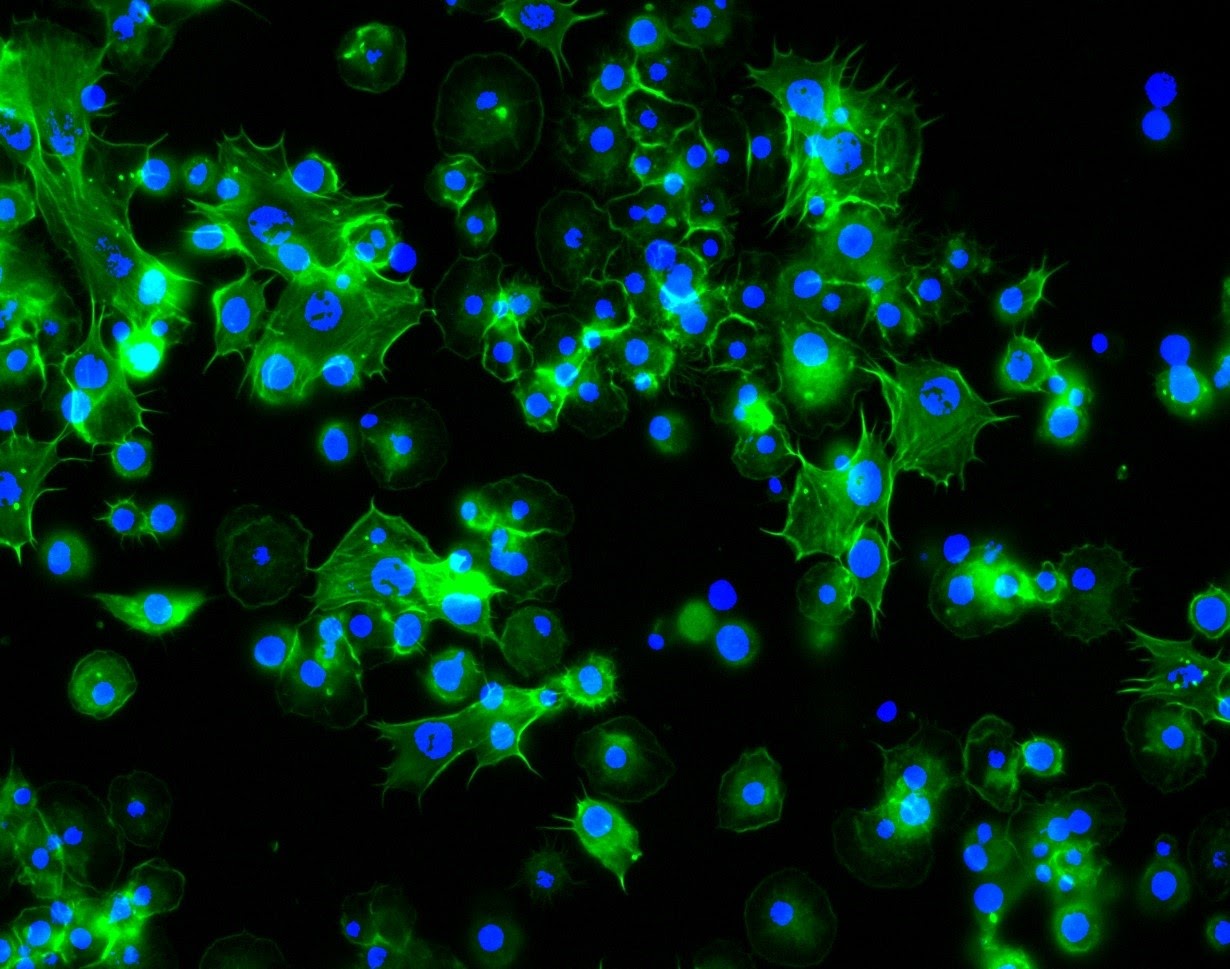
-
1. Eicosanoid biosynthetic pathways and their machineriesIn mammals, phospholipids (PLs) are rich with arachidonic acid (AA, C20:4), which is the most frequent precursor of eicosanoid biosynthesis. Except some aquatic insects, insects have little AA in their PLs. The poor AA may be reasoned by prevention of oxidative damage leading to cell death due to lipid peroxidation in insects because they might be originated from oxygen-rich environment during Paleozoic era. However, insect PLs are rich in linoleic acid (LA, C18:2), which can be elongated and desaturated to form AA. To release LA, PLs need to be catalyzed by PLA2. The free AA is then oxygenated by cyclooxygenase (COX), lipoxygenase (LOX) or epoxidase (EPX) to form prostaglandins (PGs), leukotrienes (LTs), or epoxyeicosatrienoic acids (EETs). To form different PGs, PGH2 produced by COX is then isomerized into other PGs by different PG synthases. Similarly, different LTs and EETs are synthesized by specific enzymes in mammals. However, little is known in insects.
-
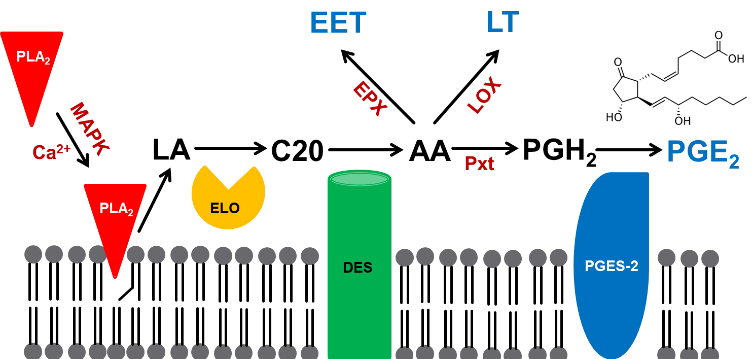
-
2. Eicosanoid signal transduction pathways in target cellsDifferent PGE2 receptors have been identified in insects from my group. Two main signaling pathways via cAMP and Ca++ have been proposed. However, there must be different PG and other eicosanoid receptors because of various eicosanoids in insects. Furthermore, downstream signals cross-talk with other signaling pathways such as Toll/IMD immune signaling pathway, nitric oxide (NO) signaling, or cytokine in insects.
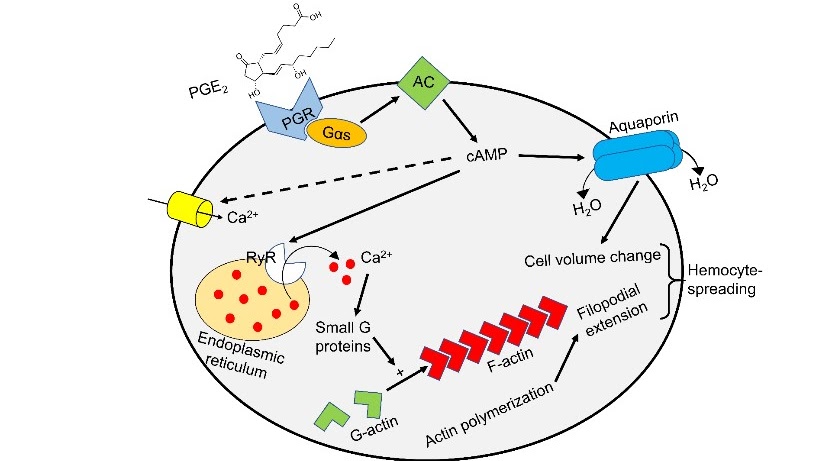
-
3. Various physiological processes mediated by different eicosanoids (CRISPR/Cas9)Why do eicosanoids have various forms? An answer might be that they can perform various physiological processes. So far, we know eicosanoids mediate immune responses, egg production, excretion in Malpighian tubule, and metabolism in fat body. However, most of processes need to be analyzed in molecular levels with current information on eicosanoid signaling pathways and biosynthetic machineries.
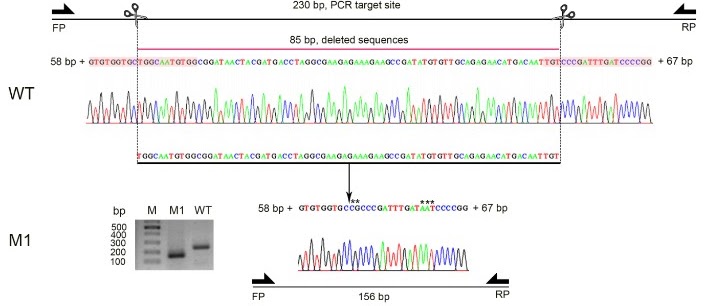
-
4. Eicosanoids in various insect systemsPolyunsaturated fatty acids (PUFAs) play crucial roles in various organisms in both plants and animals. From the rich source of linoleic acid (C18:2), algae elongate or shorten it into long chain PUFA or C12 short form like jasmonic acid (JA). Plants use JA for defense signal as well as mediating various plant growth and development. In contrast, eicosanoids and longer PUFAs are essential for mediating reproduction and immune responses in animals. Thus, diverse insects use eicosanoids to mediate their various physiological processes.
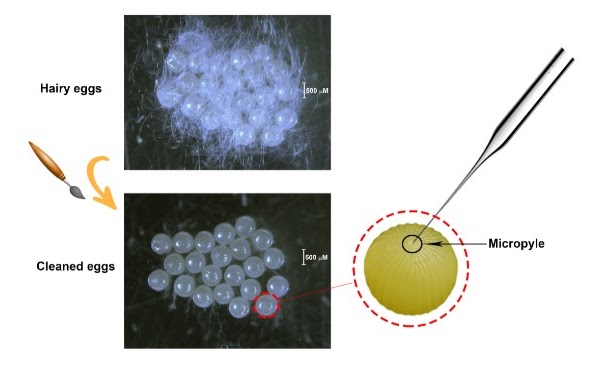
-
5. Discovery of novel insecticidesBiorational approach has been implemented to discover novel insecticides. Molecular targets for the development use various PLA2 and subsequent bioassays confirm the mode of action. These efforts recently discover novel physiological disruptors containing chemical backbone of phenylethylamide.
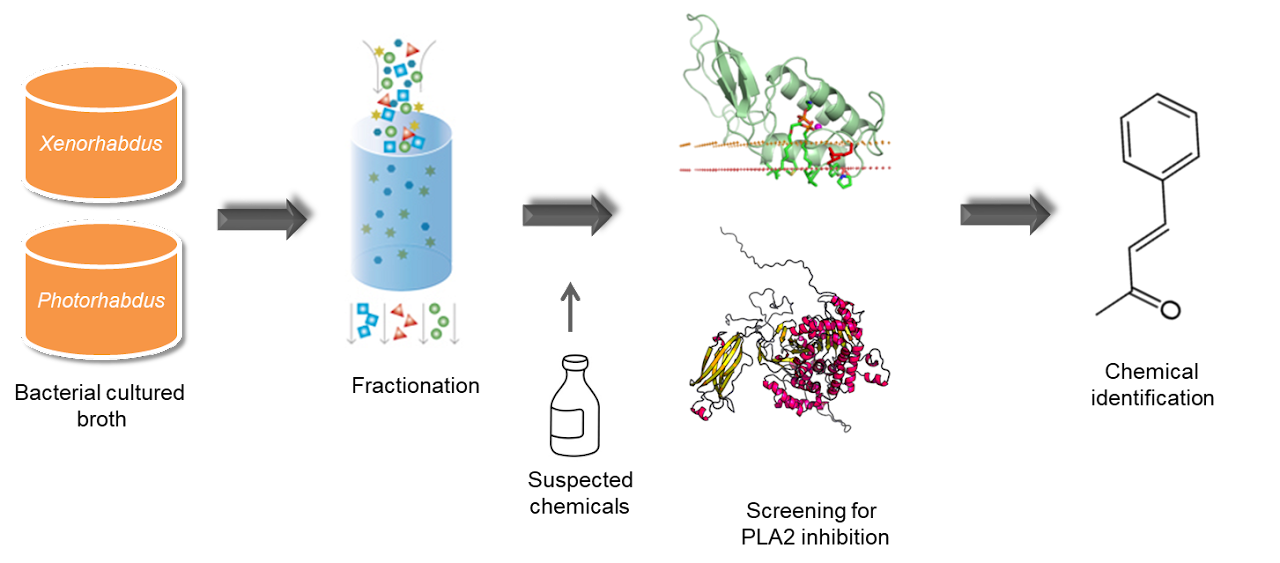
Recent SCI Publications2020Seyede MS, Shabbir A, Al Baki M, KIM Y. 2020. Prostaglandin D2 synthase and its functional association with immune and reproductive processes in a lepidopteran insect, Spodoptera exigua. Gen. Comp. Endocrinol. 287, 1-12
Al Baki M, Lee D, Jung J, KIM Y. 2020. Deletion mutant of sPLA2 using CRISPR/Cas9 exhibits immunosuppression, developmental retardation, and failure of oocyte development of legume pod borer, Maruca vitrata. Dev Comp Immunol 103, 1-15
Stanley D, KIM Y. 2020. Why most insects have very low proportions of C20 polyunsaturated fatty acids: The oxidative stress hypothesis. Arch Insect Biochem Physiol 103, 1-5.
KIM Y et al. 2020. Characterization of the first insect prostaglandin (PGE2) receptor: MansePGE2R is expressed in oenocytoids and lipoteichoic acid (LTA) increases transcript expression. Insect Biochem. Mol. Biol. 117, 1-14
Mohammad V, KIM Y. 2020. Functional interaction of bacterial virulence factors of Xenorhabdus nematophila with a calcium-independent cytosolic PLA2 of Spodoptera exigua. J Invertebr Pathol 169, 1-10.
Roy MC, Lee D, KIM Y. 2020. Host immunosuppression induced by Steinernema feltiae, an entomopathogenic nematode, through inhibition of eicosanoid biosynthesis. Insects 11, 33.
Vatanparast M, Lee DH, KIM Y. 2020. Biosynthesis and immunity of epoxyeicosantrienoic acids in a lepidopteran insect, Spodoptera exigua. Dev. Comp. Immunol. 107, 103643.
Mollah MI, Yeasman F, KIM Y. 2020. Benzylideneacetone and other phenylethyamide bacterial metabolites induce apoptosis to kill insects. J. Asia Pac. Entomol. 23, 449-457.
Roy MC, KIM Y. 2020. sPLA2 behaves like a prophylactic agent and mediates cellular and humoral immune responses in Plutella xylostella. Arch Insect Biochem Physiol. e21670.
Sajjadian SM, KIM Y. 2020. Dual oxidase-derived reactive oxygen species against Bacillus thuringiensis and its suppression by eicosanoid biosynthesis inhibitors. Front. Microbiol. 11, 528.
Al Baki, A, Vatanparast M, KIM Y. 2020. Male-biased production of the striped fruit fly, Zeugodacus scutellata, by feeding dsRNA specific to Transformer-2. Insects 11, 211.
Seo B, Kim EY, Ahn JJ, KIM Y, Kang S, Jung JK. 2020. Development, reproduction, and life table parameters of the foxglove aphid, Aulacorthum solani Kaltenbacj (Hemiptera: Aphididae), on soybean at constant temperature. Insects 11, 296.
KIM Y, Ahmed S, Al Baki A, Kumar S, Kim K, Park Y, Stanley D. 2020. Deletion mutant of PGE2 receptor using CRISPR-Cas9 exhibits larval immunosuppression and adult infertility in a lepidopteran insect, Spodoptera exigua. Dev Comp Immunol 111, 103743.
Roy MC, KIM Y. 2020. Tolerance of the mealworm beetle, Tenebrio molitor, to an entomopathogenic nematode, Steinernema feltiae, at two infection foci, the intestine and the hemocoel. J. Invertebr. Pathol. 174, 107428.
Mollah MI, Dekebo A, KIM Y. 2020. Immunosuppressive activities of novel PLA2 inhibitors from Xenorhabdus hominickii, an entomopathogenic bacterium. Insects 11, 505.
2019David S, KIM Y. 2019. Prostaglandins and Other Eicosanoids in Insects: Biosynthesis and Biological Actions. Front Physiol, e01927.
Vatanparast M, Ahmed S, Sajjadian SM, KIM Y. 2019. A prophylactic role of a secretory PLA2 of Spodoptera exigua against entomopathogens. Dev Comp Immunol 95, 108-117.
Al Baki MA, Lee DW, Jung JK, KIM Y. 2019. Insulin-like peptides of the legume pod borer, Maruca vitrata, and their mediation effects on hemolymph rehalose level, larval development, and adult reproduction. Arch Insect Biochem Physiol 100, e21524.
Md. Abdullah Al Baki, KIM Y. 2019. Inhibition of prostaglandin biosynthesis leads to suppressed ovarian development in Spodoptera exigua. J Insect Physiol 114, 83-91.
SM Sajjadian, Vatanparast M, KIM Y. 2019. Toll/IMD signal pathways mediate cellular immune responses via induction of intracellular PLA2 expression. Arch Insect Biochem Physiol 101, e21559
SM Sajjadian, Vatanparast M, D. Stanley, KIM Y. 2019. Secretion of secretory phospholipase A2 into Spodoptera exigua larval midgut lumen and its role in lipid digestion Insect Mol Biol 28, 773-784
Vatanparast M, KIM Y. 2019. Yeast engineering to express sex pheromone gland genes of the oriental fruit moth, Grapholita molesta. J Asia Pac Entomol 22, 645-654.
Shabbir A, KIM Y. 2019. An aquaporin mediates cell shape change required for cellular immunity in the beet armyworm, Spodoptera exigua. Sci. Rep. e94988
Md. Hasan, Shabbir A, KIM Y. 2019. Biosynthetic pathway of arachidonic acid in Spodoptera exigua in response to bacterial challenge. Insect Biochem. Mol. Biol. 111, 103179
Md. Abdullah Al Baki, Lee D, Jung J, KIM Y. 2019. Insulin signaling mediates previtellogenic development and enhances juvenile hormone-mediated vitellogenesis in a lepidopteran insect, Maruca vitrata. BMC Dev. Biol. 19, 1-14
Md. Hasan, Shabbir A, Imam M, KIM Y. 2019. Variation in pathogenicity of different strains of Xenorhabdus nematophila; Differential immunosuppressive activities and secondary metabolite production. J Invertebr Pathol 166: 6-17.
Ahmed S, KIM Y. 2019. PGE2 mediates cytoskeletal rearrangement of hemocytes via Cdc42, a small G protein, to activate actin remodeling factors in Spodoptera exigua (Lepidoptera: Noctuidae). Arch Insect Biochem Physiol 102, e21607.
Md. Hasan, Shabbir A, KIM Y. 2019. Overexpression of PGE2 synthase by in vivo transient expression enhances immunocompetency along with fitness cost in a lepidopteran insect. J Exp. Biol 222, 1-9
Md. Abdullah Al Baki, Kwon G, Kim D, KIM Y. 2019. Discrimination of different generations of Zeugodacus scutellata using age grading technique and their local genetic variation. J Asia Pac Entomol 22, 908-915
Jung J, SM Sajjadian, KIM Y. 2019. Hemolin, an immunoglobulin-like peptide, opsonizes nonself targets for phagocytosis and encapsulation in Spodoptera exigua, a lepidopteran insect. J Asia Pac Entomol 22, 947-956
Md. Abdullah Al Baki, Jung J, Jung J, KIM Y. 2019. Alteration of insulin signaling to control insect pest by using transformed bacteria expressing dsRNA. Pest Management Science 76, 1020-1030.
Hasan A, Yeom HS, Ryu J, Bode HB, KIM Y. 2019. Phenylethylamides derived from bacterial secondary metabolites specifically inhibit an insect serotonin receptor. Sci Rep. 9, 1-18
KIM Y et al. 2019. Survival and life table parameters of soybean pod borer Maruca vitrata (Geyer) (Lepidoptera: Crambidae) on leguminous crop cultivars. Entomol. Res. 49, 483-489.
Stanley D, KIM Y. 2019. Insect prostaglandins and other eicosanoids: from molecular to physiological actions. Adv. Insect Physiol. 56, 283-343.
2018MD Sadekuzzaman, David S, KIM Y. 2018. Nitric oxide mediates insect cellular immunity via phospholipase A2 activation. J. Innate Immun. 10, 1-12.
KIM Y, Ahmed S, Stanley D, An C. 2018. Eicosanoid-mediated immunity in insects. Dev. Comp. Immunol. 83, 130-143.
MD Sadekuzzaman, KIM Y. 2018. Nitric oxide mediates antimicrobial peptide gene expression by activating eicosanoid signaling. PLoS ONE 13, e0193282.
Shafeeq T, Ahmed S, KIM Y. 2018. Toll immune signal activates cellular immune response via eicosanoids. Dev. Comp. Immunol. 84, 408-419.
Al Baki M.A., Jung JK, KIM Y. 2018. Regulation of hemolymph trehalose titers by insulin signaling in the legume pod borer, Maruca vitrata (Lepidoptera: Crambidae). Peptides 106, 28-36.
Vatanparast M, Ahmed S, Herrero S, KIM Y. 2018. A non-venomous sPLA2 of a lepidopteran insect: its physiological functions in development and immunity. Dev. Comp. Immunol. 83-92.
Ahmed, S., Kim, Y. 2018. Differential immunosuppression by inhibiting PLA2 affects virulence of Xenorhabdus hominickii and Photorhabdus temperata temperata. J. Invertebr. Pathol. 157, 136-146.
Ahmed, S., Stanley, D., Kim, Y. 2018. An Insect Prostaglandin E2 Synthase Acts in Immunity and Reproduction. Front. Physiol. 9, 1231.
Llopis-Gimenez, Han, Y., Kim, Y., Ros, V.I.D., Herrero, S. 2018. Identification and expression analysis of the Spodoptera exigua neuropeptidome under different physiological conditions. Insect Mol. Biol. 28, 1-15.
Kim H, Keum S, Hasan A, Kim H, Jung Y, Lee D, KIM Y. 2018. Identification of an entomopathogenic bacterium, Xenorhabdus ehlersii KSY, from Steinernema longicaudum GNUS101 and its immunosuppressive activity against insect host by inhibiting eicosanoid biosynthesis. J. Invertebr. Pathol. 159, 6-17.
Kim H, Choi D, Jung J, KIM Y. 2018. Eicosanoid mediation of immune responses at early bacterial infection stage and its inhibition by Photorhabdus temperata subsp. temperata, an entomopathogenic bacterium. Arch. Insect Biochem. Physiol. 99, e21502.
Kim H, S Keum, A Hasan, H Kim, Y Jung, D Lee, Y Kim. 2018. Identification of an entomopathogenic bacterium, Xenorhabdus ehlersii KSY, from Steinernema longicaudum GNUS101 and its immunosuppressive activity against insect host by inhibiting eicosanoid biosynthesis. J Invertebr Pathol 159: 6-17.
Ahn J, K Choi, SY Huang, Md. Abdullah, S Ahmed, Y Kim. 2018. Calcium/calmodulin-dependent protein kinase II of the oriental fruit fly, Bactrocera dorsalis, and its association with rapid cold hardiness. J Asia Pac Entomol 21: 1275-1282.
2017Sunil K, KIM Y. 2017. An endoparasitoid wasp influences host DNA methylation. Sci. Rep. 7, 1-16
Park Y, Kang S, Mohamad MD, Kim H, Jung J, KIM Y. 2017. Identification and bacterial characteristics of Xenorhabdus hominickii ANU101 from an entomopathogenic nematode, Steinernema monticolum. J Invertebr Pathol 144: 74-87.
Sunil K, Jung J, KIM Y. 2017. Characterization of joining sites of a viral histone H4 on host insect chromosomes. PLoS ONE 12, 1-28.
Park Y, KIM Y. 2017. Identification of a hypertrehalosemic factor in Spodoptera exigua. Arch Insect Biochem Physiol 95, 1-12.
Sadekuzzaman MD, Park Y, Jung J, Lee S, Kim K, KIM Y. 2017. An entomopathogenic bacterium, Xenorhabdus hominickii ANU101, produces oxindole and suppresses host insect immune response by inhibiting eicosanoid biosynthesis. J Invertebr Pathol 145, 13-22.
Kim M, Lee S, Chun Y, Na J, Kim O, Kwon H, KIM Y. 2017. Heat tolerance induction of the Indian meal moth (Lepidoptera: Pyralidae) is accompanied by upregulation of heat shock proteins and polyols. Environ. Entomol. 46, 1005-1011
Sadekuzzaman MD, Neelam G, KIM Y. 2017. A novel calcium-independent phospholipase A2 and its physiological roles in development and immunity of a lepidopteran insect, Spodoptera exigua. Dev. Comp. Immunol. 77, 210-220.
Vatan MD, KIM Y. 2017. Optimization of recombinant bacteria expressing dsRNA to enhance insecticidal activity against a lepidopteran insect, Spodoptera exigua. PLoS ONE 12, 1-23.
Park Y, KIM Y, Park G, Lee J. Lee K. 2017. Supercooling capacity along with up-regulation of glycerol content in an overwintering butterfly, Parnassius bremeri. J. Asia Pac. Entomol. 20, 949-954.
Sadekuzzaman MD, KIM Y. 2017. Specific inhibition of Xenorhabdus hominickii, an entomopathogenic bacterium, against different types of host insect phospholipase A2. J Invertebr Pathol 149, 97-105.
KIM Y, Han G, Nah J, Chun Y, Sunil K, Kim O. 2017. Chlorine dioxide enhances lipid peroxidation through inhibiting calcium-independent cellular PLA2 in larvae of the Indian meal moth, Plodia interpunctella. Pestic. Biochem. Physiol. 143, 48-56
Lee D, Jung J, KIM Y. 2017. Rapid cold-hardening of a subtropical species, Maruca vitrata (Lepidoptera: Crambidae), accompanies hypertrehalosemia by upregulating trehalose-6-phosphate synthase. Environ. Entomol. 46, 1432-1438.
KIM Y, Al Baki, Kim H, Kum E, Song Y, Park Y, Kwon K. 2017. Age grading and gene flow of overwintered Bactrocera scutellata populations. J. Asia-Pac. Entomol. 20, 1402-1409.
Lee D, Cha U, KIM Y, Jung J. 2018. Identification and pheromonotropic activity of pheromone biosynthesis activating neuropeptide in Maruca vitrata. J. Asia-Pac. Entomol. 21, 156-169.
2016Sunil K, KIM Y. 2016. Glyceraldehyde-3-phosphate dehydrogenase is a mediator of hemocyte-spreading behavior and molecular target of immunosuppressive factor CrV1. Dev. Comp. Immunol. 54: 97-108.
KIM Y, Sunil K, Chun W, Eo H, Kwon H, Jeon Y, Jung J, Kim W. 2016. Anticancer and antiviral activity of chlorine dioxide by its induction of the reactive oxygen species. J. Appl. Biol. Chem. 59: 31-36.
Rahul H, KIM Y. 2016. Baculoviral p94 homologs encoded in Cotesia plutellae bracovirus suppress both immunity and development of the diamondback moth, Plutellae xylostella. Insect Sci. 23: 235-244.
Sunil K, Gu X, KIM Y. 2016. A viral histone H4 supresses insect insulin signal and delays host development. Dev. Comp. Immunol. 63: 66-77.
Park Y, Jung J, KIM Y. 2016. A mixture of Bacillus thuringiensis subsp. israelensis with Xenorhabdus nematophila-cultured broth enhances toxicity against mosquitoes Aedes albopictus and Culex pipiens pallens. J. Econ. Entomol. 109: 1086-1093.
Kim E, KIM Y. 2016. Translational control of host gene expression by a Cys-motif protein encoded in a bracovirus, Cotesia plutellae bracovirus. PLoS ONE 11, 1-22.
Sunil K, Prasad V, KIM Y. 2016. Suppressive activity of a viral histone H4 against two host chromatin remodelling factors: lysine demethylase and SWI/SNF. J. Gen. Virol. 97, 2780-2796.
Kim E, Yeum M, KIM Y, KIM Y. 2016. Transgenic expression of a viral cystatin gene CpBV-CST1 in tobacco confers insect resistance. Environ Entomol 45, 1322-1331








